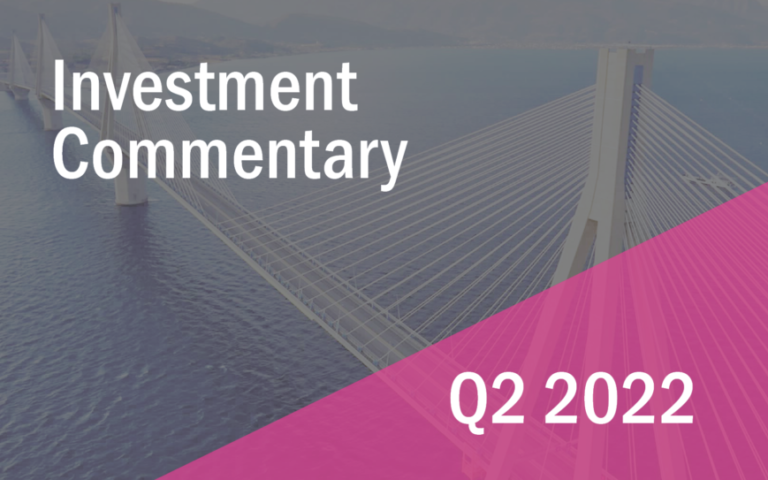Investment Commentary Q2 2022

2022 has been a challenging year for investors thus far. The S&P500, the broadest benchmark for US stocks, lost 21% through the end of June – its worst start to the year since 1970. In Canada, the TSX Composite has held up somewhat better on year-to-date basis, declining only 11% as a result of its significant exposure to energy stocks which have been 2022’s best performers.
This year has also been unusual as it is rare for both stocks and bonds to lose money at the same time. The last time this occurred on a calendar year basis was 1994. Due to climbing interest rates, the Canadian and US aggregate bond indices returned -12% and -10%, respectively, in the first half of the year so if the current trend continues 2022 will end up being a rare bad year for both stock and bond investors.
There is no shortage of those willing to predict how the rest of the year will unfold as central bankers continue to raise interest rates. However, one observation that is hard to escape is that if the economy does indeed fall into a recession, it will probably be one of most anticipated in recent memory. In other words, a recession will come as no surprise at this point which means a certain degree of bad news is likely already reflected in current equity prices.
Whenever market conditions are as challenging as they are now, the most frequent questions asked by clients are: When do you think the market will recover and do you think the market will keep dropping? These are natural questions to ask, but of course the only honest answer is we don’t know.
However, we can say a few things with a high level of certainty:
- The stock market always goes through periods of decline – unfortunately no one has ever shown any degree of consistency in predicting when these periods will occur.
- Despite short term drops, the stock market has always gone up over longer periods of time and has rewarded investors with an investment return that is higher than what can be earned from lower risk assets like government bonds and GICs.
- If stock market volatility causes one to sell every time the market goes down and buy only after it appreciates, then such an investor is usually better off simply investing in government bonds and GICs as buying high and selling low is always a losing strategy.
- Diversification is the one “free lunch” in investing as it allows you to maximize investment returns, while reducing risk and volatility.
As opposed to focusing on predicting the short-term direction of the stock market (point #1 above), the more relevant investment questions are: Do I have the appropriate long-term asset allocation given my investment objectives and risk tolerance and are any adjustments necessary in light of current market conditions? Focusing on the answers to these questions helps one to remain invested for the long term and earn higher rates of return (point #2 above).
We put considerable effort at Bridgeport into ensuring our clients have an appropriate asset allocation so that portfolio volatility and losses are reduced during challenging times. We believe this makes it easier to avoid the emotional roller coaster which can lead to the buy high / sell low pattern discussed in point #3 above.
Investment diversification (point #4 above) is a critical component of asset allocation. And by investment diversification, we don’t mean you have to own hundreds of individual stocks as that approach often results in owning many marginal businesses. In fact, most studies demonstrate that the benefits of diversification within a given stock market segment are minimal after investing in about 20-30 high quality stocks which is why Bridgeport’s equity funds adhere to this strategy.
Rather, in terms of reducing portfolio volatility, diversification is usually more important across various asset classes. By asset classes, we are referring to segments such as publicly traded stocks, bonds, preferred shares and alternative assets like private equity, venture capital, real estate, infrastructure and private lending.
The benefits of this asset class diversification have been evident for years to institutional investors which is why we pursue the same strategy on behalf of clients. The value of including alternative assets in your portfolio has been particularly clear so far in 2022 as all our private asset portfolios either increased or essentially held their value through June 30, which has helped to mitigate overall portfolio declines for our clients along with good relative performance against benchmarks in many of our other funds.
Finally, it is worth highlighting the many stock and bond opportunities that have become available as a result of the current environment. The average yield on fixed income investments in our High Income Fund is now in the 6% – 7% range which is close to 2% higher than it was six months ago. This increase in yield should bode well for future fund returns. For example, we recently purchased a bond issued by the security company Brinks which matures in 2027 and yields approximately 7% which we think offers good value. In our three equity funds, we similarly are evaluating numerous opportunities that are trading at more compelling earnings multiples as compared to recent history.
As always, please feel free to reach out with any questions. We wish you all the best for a healthy and enjoyable summer.
Yours truly,
John Fisher